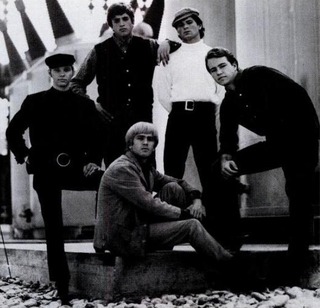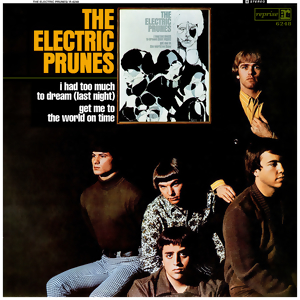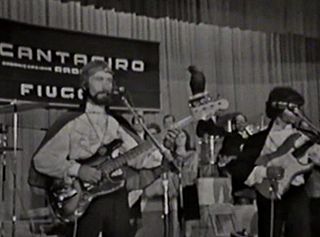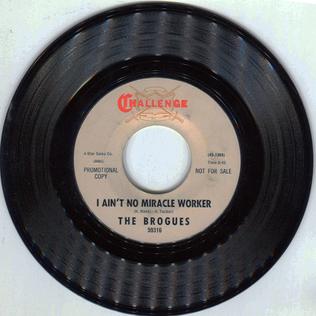Garage rock is a raw and energetic style of rock and roll that flourished in the mid-1960s, most notably in the United States and Canada, and has experienced a series of subsequent revivals. The style is characterized by basic chord structures played on electric guitars and other instruments, sometimes distorted through a fuzzbox, as well as often unsophisticated and occasionally aggressive lyrics and delivery. Its name derives from the perception that groups were often made up of young amateurs who rehearsed in the family garage, although many were professional.

The Electric Prunes are an American psychedelic rock band, formed in Los Angeles, California, in 1965. Much of the band's music was, as music historian Richie Unterberger described it, possessed of "an eerie and sometimes anguished ambiance." Their most successful material was by songwriters Annette Tucker and Nancie Mantz, though the group also penned their own songs. Incorporating psychedelia and elements of embryonic electronic rock, the band's sound was marked by innovative recording techniques with fuzz-toned guitars and oscillating sound effects. In addition, guitarist Ken Williams' and singer James Lowe's concept of "free-form garage music" provided the band with a richer sonic palette and exploratory lyrical structure than many of their contemporaries.

Nuggets: Original Artyfacts from the First Psychedelic Era is a compilation album of American psychedelic and garage rock singles that were released during the mid-to-late 1960s. It was created by Lenny Kaye, who was a writer and clerk at the Village Oldies record shop in New York. He would later become the lead guitarist for the Patti Smith Group. Kaye produced Nuggets under the supervision of Elektra Records founder Jac Holzman. Kaye conceived the project as a series of roughly eight LP installments focusing on different US regions, but Elektra convinced him that one double album would be more commercially viable. It was released on LP by Elektra in 1972 with liner notes by Kaye that contained one of the first uses of the term "punk rock". It was reissued with a new cover design by Sire Records in 1976. In the 1980s, Rhino Records issued Nuggets in a series of fifteen installments, and in 1998 as a 4-cd box set.
Psychedelic folk is a loosely defined form of psychedelia that originated in the 1960s. It retains the largely acoustic instrumentation of folk, but adds musical elements common to psychedelic music.

The Brogues were an American garage rock band formed in Merced, California, in 1964. Much of the group's brief recording career was marked by distorted-guitar melodies and R&B-influenced vocals. They released two regionally successful singles in their brief existence, most notably the Annette Tucker and Nancie Mantz-penned "I Ain't No Miracle Worker", which is now considered a classic of the garage rock genre. The song has also appeared on several compilation albums and has been covered by other music artists.

Mass in F Minor is the third studio album by American rock band The Electric Prunes, released in 1968. It consists of a musical setting of the mass sung in Latin and Greek and arranged in the psychedelic style of the band, and was written and arranged by David Axelrod.

Underground is the second studio album by the American garage rock band, The Electric Prunes, and was released in 1967 on Reprise Records. It would be the final album of any materialized input by band members until the 1969 "New Improved" Electric Prunes were formed. The album was a moderate chart hit, but, without a hit-ready single, the band could not repeat their past success.
Walter David Hassinger was an American Grammy award-winning recording engineer and record producer.

Annette May Tucker is an American songwriter, who found success in the 1960s as co-writer of songs for The Electric Prunes, The Brogues, The Knickerbockers, Nancy and Frank Sinatra and others.

"Psychotic Reaction" is the debut single by the American garage rock band Count Five, released in June 1966 on their debut studio album of the same name.

The Electric Prunes, sometimes referred to as I Had Too Much to Dream (Last Night), is the 1967 debut album by the American garage rock band, the Electric Prunes, released on Reprise Records. The first track, "I Had Too Much to Dream (Last Night)", was a hit and became the band's signature tune. The album also contains another notable psychedelic rock composition, "Get Me to the World on Time". The album was listed in the book 1001 Albums You Must Hear Before You Die.
Opal Butterfly was an English psychedelic rock group from Oxfordshire, which was active between 1968 and 1970. Although the band itself did not gain widespread success, the musicians did go on to conduct successful musical careers. The band included Simon King (drums) and, for a short time, Lemmy, who later joined Hawkwind. Further members were Robert "Robbie" Milne, Allan Love, Richard Bardey and Tommy Doherty. The band released three official singles in the heavy psychedelic rock style before disbanding.

Mark Shalom Tulin was an American bass guitarist who played with the psychedelic rock band The Electric Prunes.

The Inner Mystique is the second album by the American garage rock band The Chocolate Watchband, and was released in 1968 by Tower Records.

The Astronauts were an American rock band, who had a minor hit in 1963 with "Baja" and remained successful for several years, especially in Japan. They have been described as being, "along with...(the) Trashmen, the premier landlocked Midwestern surf group of the '60s." For most of their career, the band members were Rich Fifield, Jon "Storm" Patterson, Bob Demmon, Dennis Lindsey, and Jim Gallagher.

Artifact is an album by The Electric Prunes, self-released in 2001. It was their first studio album since 1969.

"Get Me to the World on Time" is a song written by Annette Tucker and Jill Jones for the American garage rock band, The Electric Prunes. The song was released in March 1967 following the success of the band's previous single, "I Had Too Much to Dream ". Although the follow-up did not have the same success, "Get Me to the World on Time" still charted at number 27 on the Billboard Hot 100. The single also fared slightly better in the UK, where it reached number 42.

Thaddeus James Lowe is an American musician and record producer, best known as the lead singer of 1960s psychedelic rock band The Electric Prunes and as an audio engineer and producer with Todd Rundgren and the band Sparks.

I Corvi is an Italian beat group who were successful in the 1960s.

"I Ain't No Miracle Worker" is a song by the American garage rock band, the Brogues, written by Annette Tucker and Nancie Mantz, and released as the group's second and final single on Challenge Records, in November 1965. The composition is now considered a classic of the musical genre of garage rock, and has reappeared on several compilation albums and has been covered by other musical artists. The Brogues' original rendition was musically influenced by their contemporaries on the R&B circuit and the British Invasion.
















